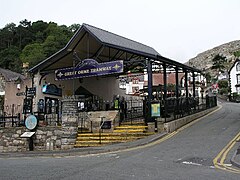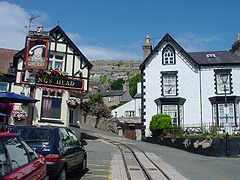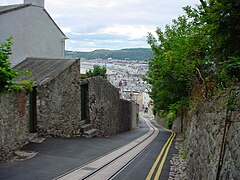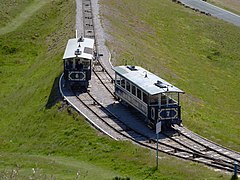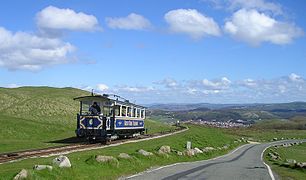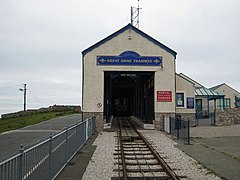
A cable car is a type of cable railway used for mass transit in which rail cars are hauled by a continuously moving cable running at a constant speed. Individual cars stop and start by releasing and gripping this cable as required. Cable cars are distinct from funiculars, where the cars are permanently attached to the cable.
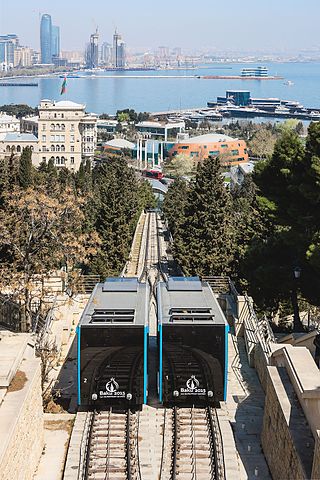
A funicular is a type of cable railway system that connects points along a railway track laid on a steep slope. The system is characterized by two counterbalanced carriages permanently attached to opposite ends of a haulage cable, which is looped over a pulley at the upper end of the track. The result of such a configuration is that the two carriages move synchronously: as one ascends, the other descends at an equal speed. This feature distinguishes funiculars from inclined elevators, which have a single car that is hauled uphill.

An aerial tramway, aerial tram, sky tram, aerial cablecar, aerial cableway, telepherique, or seilbahn is a type of aerial lift which uses one or two stationary ropes for support while a third moving rope provides propulsion. With this form of lift, the grip of an aerial tramway cabin is fixed onto the propulsion rope and cannot be decoupled from it during operations. In comparison to gondola lifts, aerial tramways generally provide lower line capacities and higher wait times.

Llandudno is a seaside resort, town and community in Conwy County Borough, Wales, located on the Creuddyn peninsula, which protrudes into the Irish Sea. In the 2021 UK census, the community – which includes Gogarth, Penrhyn Bay, Craigside, Glanwydden, Penrhynside, and Bryn Pydew – had a population of 19,700. The town's name means "Church of Saint Tudno".

The Peak Tram is a funicular railway in Hong Kong, which carries both tourists and residents to the upper levels of Hong Kong Island. Running from Garden Road Admiralty to Victoria Peak via the Mid-Levels, it provides the most direct route and offers good views over the harbour and skyscrapers of Hong Kong. Operated since 1888, it was the first funicular railway in Asia.

The Lauterbrunnen–Mürren Mountain Railway is a hybrid transport system in the Bernese Oberland area of Switzerland, which connects the villages of Lauterbrunnen and Mürren. The system consists of a connected aerial cableway, also known as the Grütschalpbahn, and an adhesion worked mountain railway. The cableway replaced a funicular, on the same route, in 2010.

The Great Orme is a limestone headland on the north coast of Wales, north-west of the town of Llandudno. Referred to as Cyngreawdr Fynydd by the 12th-century poet Gwalchmai ap Meilyr, its English name derives from the Old Norse word for sea serpent. The Little Orme, a smaller but very similar limestone headland, is on the eastern side of Llandudno Bay. The headland is a tourist attraction, with a Victorian tramway, a cableway, walking routes and a mining museum.

Gauntlet track or interlaced track, also gantlet track (AE) is an arrangement in which railway tracks run parallel on a single track bed and are interlaced in such a way that only one pair of rails can be used at any time. Since this requires only slightly more width than a single track, all rails can be carried on the same crossties/sleepers. Trains run on the pair of rails appropriate to their direction, track gauge or loading gauge.
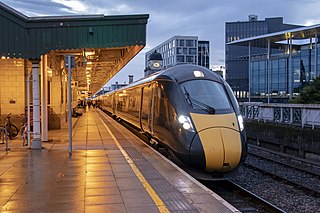
Transport in Wales is heavily influenced by the country's geography. Wales is predominantly hilly or mountainous, and the main settlements lie on the coasts of north and south Wales, while mid Wales and west Wales are lightly populated. The main transport corridors are east–west routes, many continuing eastwards into England.

The Wellington Cable Car is a funicular railway in Wellington, New Zealand, between Lambton Quay, the main shopping street, and Kelburn, a suburb in the hills overlooking the central city, rising 120 m (394 ft) over a length of 609 m (1,998 ft).
The Guindais Funicular is a funicular railway in the civil parish of Cedofeita, Santo Ildefonso, Sé, Miragaia, São Nicolau e Vitória, Portuguese municipality of Porto.
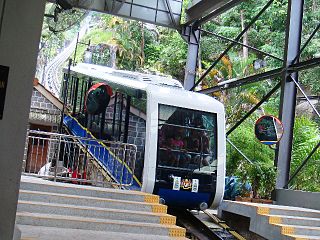
The Penang Hill Railway is a one-section funicular railway which climbs the Penang Hill from Air Itam, on the outskirts of the city of George Town in the Malaysian state of Penang. The railway first opened in 1923 as a two-section railway, but was overhauled in 2010 into a one-section system. It is a single-track railway with a passing loop, and it passes through a tunnel which is the steepest in the world. The total journey time can take between five and twenty minutes. The funicular train coach travels directly from the lower station to the top, but may stop at other intermediate stations upon request.

The Trieste–Opicina tramway is an unusual hybrid tramway and funicular railway in the city of Trieste, Italy. It links Piazza Oberdan, on the northern edge of the city centre, with the village of Villa Opicina in the hills above.
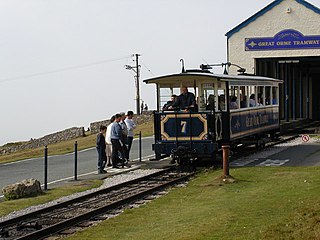
The Summit tram stop is a tram terminus situated on the Great Orme Tramway at the summit of the Great Orme in Llandudno, Wales. The Great Orme Tramway is a funicular, which connects the summit with a lower terminus at Victoria in the centre of Llandudno. From the summit station, access is available to the Great Orme Country Park Visitor Centre, the Summit Complex and cafe, a large outdoor playground, and the many walks on the Orme.

Hurst, Nelson and Company Ltd was a railway rolling stock manufacturer based in Motherwell, Scotland. The company also built many railway wagons, as well as trams and trolleybus carosseries for several local authorities.

The Dolderbahn is a 1.3 km (0.81 mi) long rack railway in the Swiss city of Zürich. The line is in Zürich's Hottingen and Fluntern suburbs on the south slope of the Adlisberg mountain. The lower terminus of the line is at Römerhof, some 1.5 km (0.93 mi) from the city centre, where it connects with lines 3 and 8 of the Zürich tramway. The upper terminus at Bergstation Dolderbahn is adjacent to the Dolder Grand Hotel and the Dolder recreation area. Two intermediate stations, at Titlisstrasse and Waldhaus Dolder, are also served.

The Llandudno Cable Car is an attraction in the seaside resort of Llandudno in Conwy County Borough, Wales. The cable car runs along the Great Orme spanning a distance of one mile forty feet (1.622 km) exactly. The cable car was opened in summer 1969, and has been operational ever since. The cabins give views of the Irish Sea looking over to Rhyl and the Isle of Man, as well as the Snowdonia National Park. There are currently 20 cabins in service, which leave each station at approximately one-minute intervals. The cabins are painted in red, yellow, orange, light blue and purple. The cable car is now owned by Kinetics Industrial Ltd. The highest point from the ground is around 80 feet (24.38 m). Nine pylons support the cable.

The Swansea Constitution Hill Incline Tramway operated a cable funicular tramway service on Constitution Hill in Swansea between 1898 and 1901.

Llandudno Victoria tram stop is the lower terminus of the Great Orme Tramway, situated in the centre of the town of Llandudno, Wales. The Great Orme Tramway is a funicular, which connects this terminus to the Halfway and Summit stops on the Great Orme.

The Halfway tram stop is a tram stop situated at the midpoint of the Great Orme Tramway on the slopes of the Great Orme in Llandudno, Wales. The Great Orme Tramway operates as a two-section funicular, and passengers must change at Halfway between the lower section and the upper section. The stop is also convenient for the nearby Bronze Age Copper Mines.




